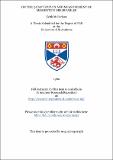Files in this item
On the quantization and measurement of momentum observables
Item metadata
| dc.contributor.advisor | Wan, Kong K. | |
| dc.contributor.author | McFarlane, Keith | |
| dc.coverage.spatial | 212 p. | en_US |
| dc.date.accessioned | 2018-06-25T13:39:45Z | |
| dc.date.available | 2018-06-25T13:39:45Z | |
| dc.date.issued | 1980 | |
| dc.identifier.uri | https://hdl.handle.net/10023/14543 | |
| dc.description.abstract | This thesis is the outcome of research conducted into the quantization of observables defined over a Riemannian configuration manifold, and is naturally divided into three chapters: The first chapter is essentially concerned with the development from physical bases, of the concepts of classical and quantum “global measurability”, which, when combined with the requirement that all quantizable momenta shall be either classically or quantum mechanically globally measurable, result in the exclusion form the class of quantizable momenta of all those observables which are not quantizable in accordance with G. W. Mackey’s natural procedure. The refinement of exact global measurability is then introduced and the physically important class of “killing” momenta are found to be exactly classically and quantum mechanically globally measurable and moreover quantizable by means of Mackey’s scheme. The second chapter seeks to analyse the algebraic structure of the Mackey-quantizable momenta, so as to compare and contrast his geometric scheme with the various algebraic schemes which have frequently been proposed. As an extension of this work, a natural geometric quantization is proposed for the more general class of observables “linear in momentum”, the set of quantizable such entities determines, and its algebraic properties discussed. It is concluded that, if Mackey’s procedure is, as we argue, correct and exhaustive of the quantizable momenta, then algebraic rules of quantization do not, in general, obtain among the momenta defined over a Riemannian space, ‘though in the case of momenta, such as the Killing momenta, reflecting the symmetry of the configuration manifold, such laws not only exist but are moreover of great practical importance. The third chapter is concerned with the quantization of the observables “multilinear in momentum” and in particular with the delimitation of the possible operators of formal quantization as circumscribed by the requirement of operator symmetry, and the question of the essential self-adjointness of local observables associated with the multilinear momenta. Finally some possible means of determining and exact quantization are discussed and contrasted and a tentative selection made of a particular scheme which is then illustrated by concrete example on the real line with the usual metric. We conclude this preface with a brief indication of the layout of the thesis: Each chapter or associated group of appendices has been treated for the purpose of all textual numbering and referencing systems, as a separate unit, and is prefixed by a detailed list of contents, and concluded by the appropriate group of reference, so that all pointers of a chapter or group of appendices refer, unless otherwise indicated, to the text of that chapter or group of appendices. Finally note that a bibliography has been included which will serve as a collected list of references to papers and books employed. | en_US |
| dc.language.iso | en | en_US |
| dc.publisher | University of St Andrews | |
| dc.subject.lcc | QC174.17M7M5 | |
| dc.subject.lcsh | Quantum measure theory | en |
| dc.title | On the quantization and measurement of momentum observables | en_US |
| dc.type | Thesis | en_US |
| dc.type.qualificationlevel | Doctoral | en_US |
| dc.type.qualificationname | PhD Doctor of Philosophy | en_US |
| dc.publisher.institution | The University of St Andrews | en_US |
This item appears in the following Collection(s)
Items in the St Andrews Research Repository are protected by copyright, with all rights reserved, unless otherwise indicated.

